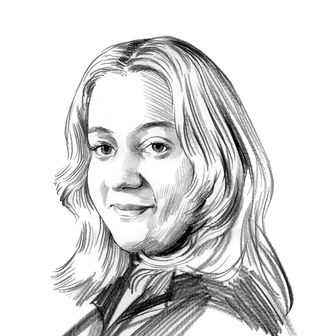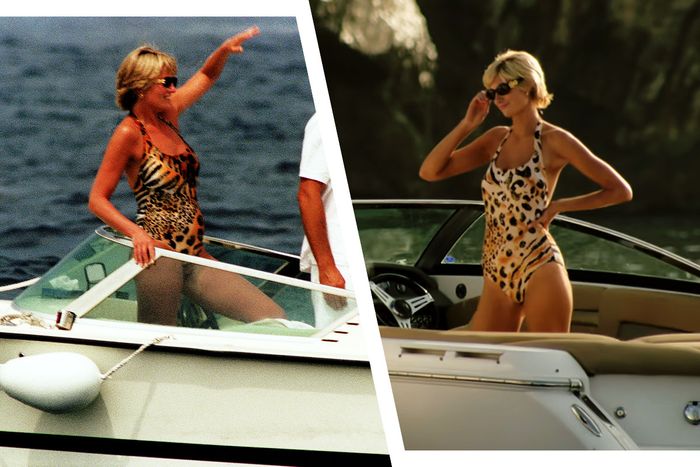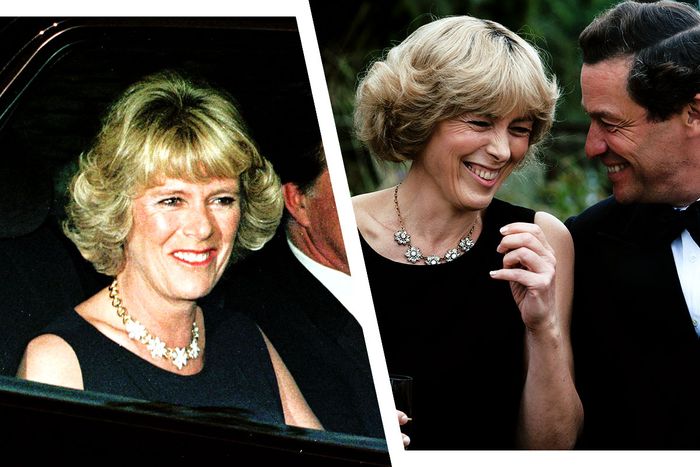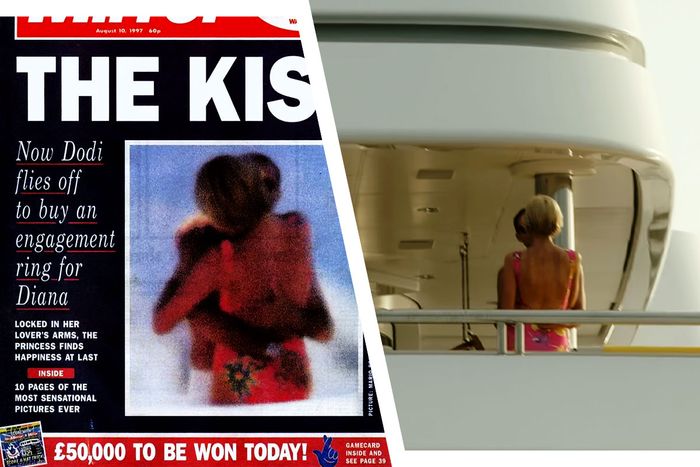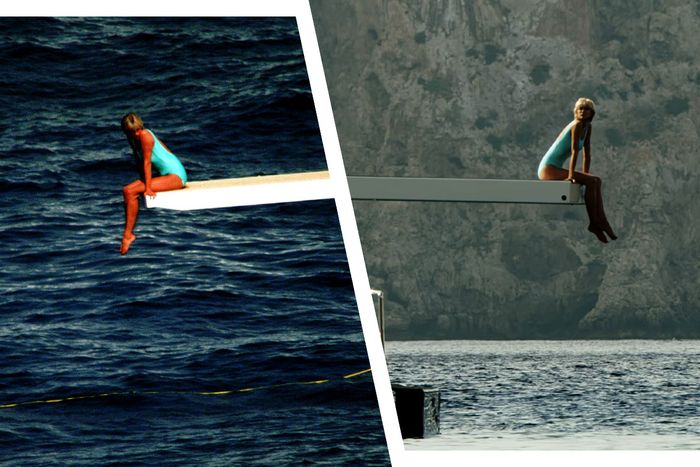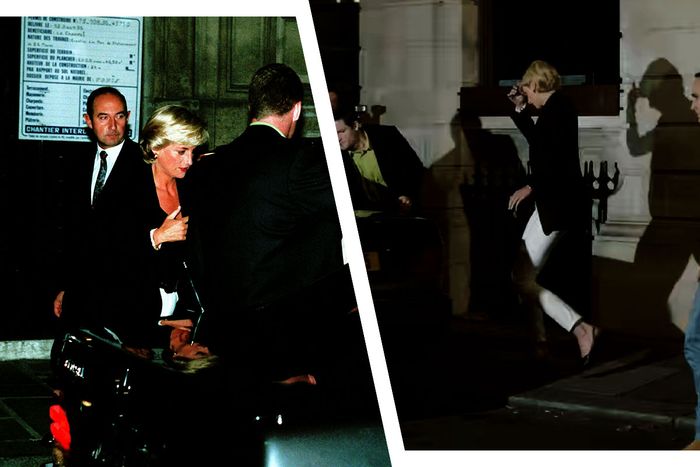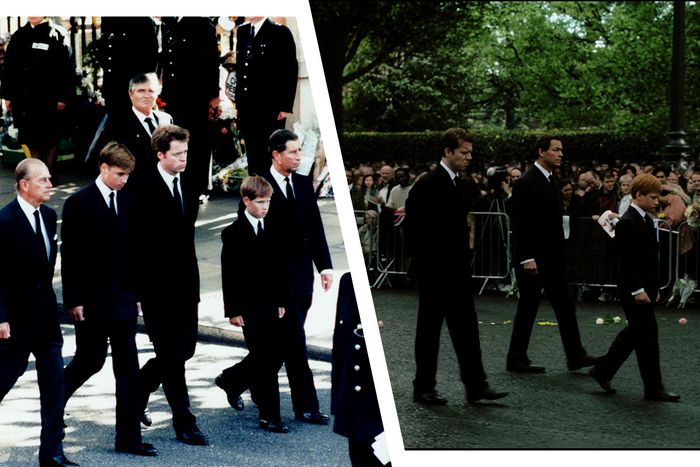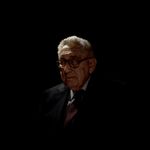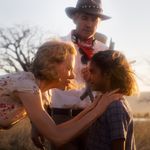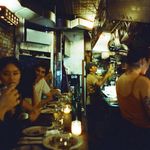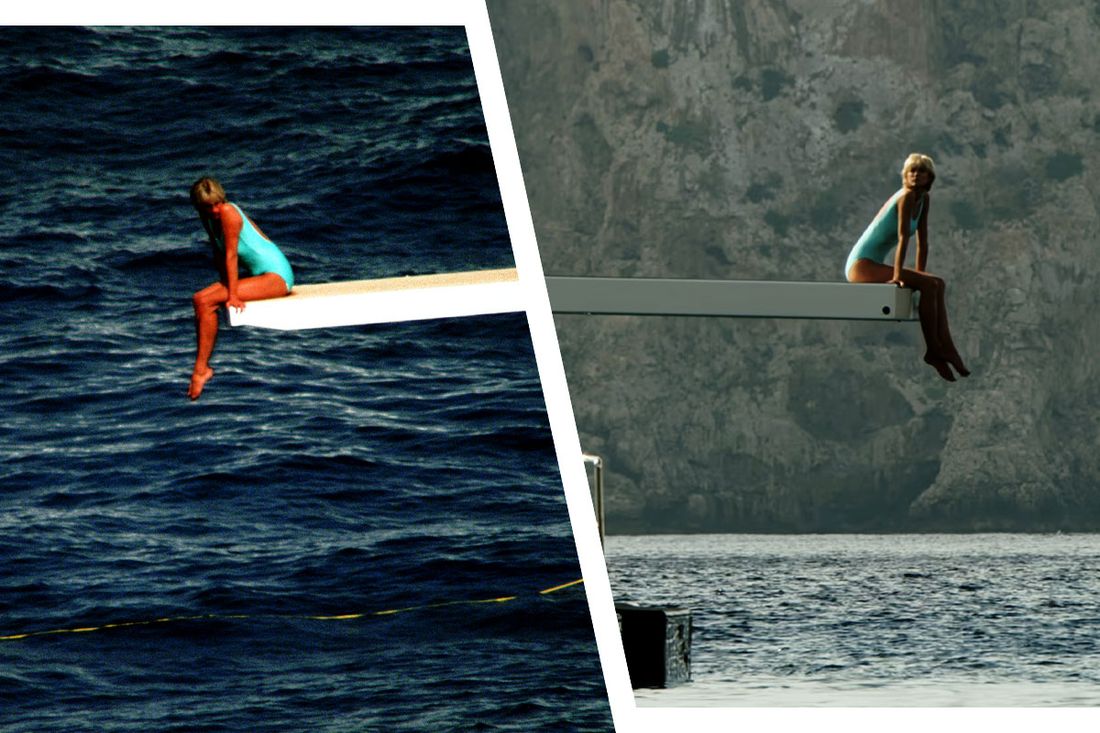
The first four episodes of The Crown’s final season may as well be called The Di Summer Collection. Most of the action parts ways with the Thames in favor of the sunnier Mediterranean Sea during the summer of 1997, with Diana (Elizabeth Debecki) and Dodi Fayed (Khalid Abdalla) kindling a romance that culminates in their tragic deaths in Paris after being chased through a tunnel by the paparazzi. (They also return as ghosts for some reason.) Re-creating the final days of the People’s Princess was an exercise in both visual accuracy and creative liberty: While the tabloid images of her that proliferated at the time provided ample starting points, “we’re not making a documentary,” says set designer Alison Harvey. “You have to make it your own.”
That meant looking at some of the most famous images from Diana’s final summer and not only re-creating them in a way that would be instantly familiar to viewers, but also finding deeper emotional truths within the two-dimensional images. The season kicks off with Diana taking her sons on a yachting holiday in Saint-Tropez at the invitation of Mohamed Al-Fayed, who’s looking to set up the princess with his son Dodi. The series explores the couple’s burgeoning intimacy in scenes that directly parallel those famous paparazzi photos, which proved difficult to shoot on the water at times. However, everything that made the final cut exemplified The Crown’s clear grammar of the way it films each of its royals — with some added irony thrown in. “For Diana’s scenes, it was so chaotic to shoot. You have about 15 boats and people are throwing up because they have to stay out there for hours until we get the shot,” director Alex Gabassi explains. “Then, with Camilla, you have those nice crane shots and everything is smooth. For me, that says it all.”
Diana’s paparazzi sea showdown
“Most of our conversations throughout this episode had to do with how much we wanted to portray her as a mother,” explains Gabassi, who directed episode one. “We knew it would be very sparse when you see her with the kids. We needed to put as much of that love out there as possible.” This maternal behavior gave the iconic leopard swimsuit a deeper meaning. “We knew there was that particular photo of her,” he says. “But we’re always tempted to give as much ambiguity as possible.”
Gabassi and The Crown creator and writer Peter Morgan settled on showcasing Diana’s style as a parent, with the impetus of her emerging in the swimsuit being that her son William feels compelled to stay inside the yacht in order to avoid the swarm of cameras. “We needed to strike a balance between her taking care of the kids and sacrificing herself by going out with the swimsuit,” he says. “She was giving them what they needed in order to be left in peace.”
The other side of that, however, was the looming specter of competing with Camilla’s 50th birthday party in the press. “Diana couldn’t appear as being someone with that kind of narcissism who just wanted to win over Charles and Camilla’s attention by the press,” Gabassi notes. “We wanted to give a bit of that, but also a sense that she would come out as a mother figure in order to protect her children.”
Gabassi’s read of the scene brought forth a minor disagreement between the director and Debecki: “I remember asking Elizabeth, ‘Could you pose a little bit at the end of the scene?’ And she said, ‘Do you think it’s right? I’m not sure about that.’ I responded, ‘There’s something incredibly attractive and yet dangerous in the way that you’re given all that attention.’ When she goes in and she knows these guys, she talks to them and calls them by their names and there’s a kind of camaraderie. You think to yourself, Oh, they might be friends. These guys are quite nice. At that moment, I think Diana was enticed by the idea of playing a figure that everybody loves.”
Gabassi ensured this was followed through in the post-mixing sessions with Morgan, when one paparazzo verbalizes to his peers to wrap it up and depart in their boats. “The negotiation paid off,” Gabassi says. “She gave something, and they got something. The conversation was always about how much Diana knew how to play the paparazzi. It’s been clear that she knew how to do it, which is something Camilla doesn’t know how to do.”
While Gabassi was consumed with the paparazzi’s motives, Harvey was tasked with their equipment. The main problem? Procuring the vast amount of lenses required for each person, which on the vintage market can cost up to $20,000 each. (A quick scan of the scene estimates more than two dozen would’ve been required.) For cost reasons, Harvey decided to make them as props. “It was more prosaic,” she admits, “but it had to be done that way.” Costume designer Sid Roberts had a bit more fun re-creating Diana’s leopard look. “The swimsuit is the new ball gown,” she says. Her team got in touch with Gottex, the Israeli company that made several of Diana’s swimsuits that summer — including the leopard one — and they agreed to collaborate on this season of The Crown. “Its leopard print leans into Diana’s animalistic strengths. It plays up to a safari,” Roberts explains. “I love that the swimsuit was for this moment because she’s in the wild, if you like, and she’s literally being hunted by photographers.”
Camilla’s 50th birthday party
While Diana is enjoying her sun-kissed summer, Camilla and Charles are back home in dreary old England to celebrate Camilla’s 50th birthday with an elegant soiree. Gabassi was forced to film on a “terrible and disastrously rainy day,” a weather pattern that helped inform the ease of their love.
“The first scene I did with Camilla was looking through the window down to Charles preparing the party,” he says. “I told Olivia Williams, ‘What can we do here that implies the connection is deeper now and she’s being accepted by him?’ I put her in the bedroom, waking up and coming out of bed. That wasn’t scripted. She’s in her nightgown and she’s being embraced by Charles. She’s part of that household.” The bookend of this scene comes from the speech Charles gives to Camilla later on at the party, which needed to come off as sincere as possible. “Camilla had been that kind of person,” Gabassi notes, “resilient and facing so much adversity, but she’s still there.”
And, yes, there’s a reason the only member of the royal family at Camilla’s birthday party is Margaret, and it’s not factual accuracy. (There’s no record of her being in attendance at the time.) “It echoes what she’s suffered and she could never achieve with true love. It was important for the audience to understand that this is a very steady relationship,” Gabassi says. “It’s interesting to see that being seen through the eyes of Margaret, who had gone through both stages — a crazy chaotic relationship and then someone who accepted her but still wasn’t quite right.”
Diana and Dodi’s kiss
As with Diana boating to the paparazzi to defend her boys, this was another instance of The Crown re-creating a moment and giving it additional narrative context. In the show, the image, which featured the couple kissing and embracing on the yacht, is set in motion by the couple having a heartfelt conversation about Diana’s priorities in life.
“It’s intimate, but there’s a sexiness and an affection between the two,” says Christian Schwochow, who directed episodes two through four. “They talk about something that really matters for Diana, which is the landmine charity. I think it’s a great idea to have one of the most beautiful moments in their relationship be about how much he cares about her and how much she cares for the charity work. When we actually see her doing the charity work later in the episode, it gets destroyed by the journalists because of this photo.”
Unlike with the leopard-print swimsuit shots, though, Diana’s pink floral ensemble is one of the less iconic aspects of these photos. That was freeing for Roberts, who was given free rein in remaking the swimsuit, which wasn’t a Gottex creation. “It was our time to play. I closed my eyes and thought, What do you remember about that swimsuit? What’s the essence? It’s a pink hue and there’s a real vibrancy,” she says. “This is her second holiday with Dodi, so they’re flirting. There has to be a kind of sexiness to all the stuff she wears.” Roberts created eight versions before she felt she properly translated the original in terms of the colors and scale of the flowers.
The story of this photo includes a third major character besides Diana and Dodi: the photographer who captured the kiss, Mario Brenna, who stated in a recent New York Times interview that his portrayal is inaccurate. While The Crown shows him being hired by Mohamed al-Fayed, Brenna claims he fortuitously encountered the yacht while on vacation. Regardless, the photo and its reported cost of sale ($2.1 million) encompass Diana’s deteriorating relationship with the paparazzi. “I hope viewers get a sense that a photo can destroy a person’s life,” Schwochow says.
Diana’s yachtside contemplation
The final scene of episode two features the most prevalent image of Diana’s time in the sun: the princess sitting, deep in thought, on the side of the Fayed superyacht. (Despite the appearance of a diving board, the plank is, in fact, a landing jetty.) “Everything that’s known as an image we tried to re-create as faithfully as we could within the constraints of taste, decency, and copyright,” set designer Alison Harvey says. For Schwochow, that meant capturing the “emotional truth” of the moment and Diana’s summer fling with Dodi — which at this point in the series had been going on for just over one week. “We feel that Diana is incredibly restless,” he explains. “There’s happiness, but there’s also quite a messiness in her life. We used this moment to create this forlornness and melancholy.”
Schwochow worked with Debicki for several hours to find “different physical positions” to best match the scene. While he filmed a few shots of paparazzi taking photos of Diana on the jetty, he ultimately didn’t use them in order to enhance the moment’s vulnerability. “There’s no magic trick to re-creating it — it’s just the actress and me,” he says. “The first shot on the boat behind her with the camera took an hour. Then some of the crew had to jump on a small tender, get to the shore, and get settled there with the boat’s captain. It takes a lot of time to find the perfect position off the boat to have the best sunlight.”
The other element of the shot that absolutely had to be correct was Diana’s blue swimsuit, which Roberts considers to be her third defining Crown silhouette, after the wedding dress and the revenge dress from earlier seasons. “I love the trajectory of those three silhouettes because it’s like the chrysalis of a butterfly,” she says. “We knew we had to do the blue swimsuit since the moment was so iconic and has the same significance in our story.” Roberts’s main priority in re-creating the swimsuit was capturing the color “because it’s this beautiful block of blue amongst her and the seas.” However, she also had to consider Debicki’s tall frame. “It’s vulnerable for an actor to go out on a diving board in just a swimsuit,” she adds. “The ’90s was very unforgiving in how high it was cut on the thigh and the hip. A lot of that for us was working out where Elizabeth would be comfortable.”
Diana and Dodi leave the Ritz
For Schwochow, the season’s defining tragedy begins in the anteroom before Diana and Dodi leave the hotel — which is possible to depict thanks to ample CCTV footage. “What’s interesting about the footage is you could see that they were laughing together. We saw Dodi gently touching her back and giving her comfort,” Schwochow notes. “We felt like they’re very much at ease and she feels very comfortable in his presence. That’s why we improvised on that night. We can’t hear what they say in the original footage, but it felt like they had this little moment of ‘Oh my God, what are we doing? Where have we ended up being together?’”
“This was a look I felt duty-bound to get accurate, so that the tragedy and sensitivity of the scene wouldn’t be interfered with,” Roberts explains, citing Diana’s Ritz look as the most difficult to re-create this season. The shoes and blazer were specially made for The Crown, while the jeans and top were contemporary Max Mara pieces with a ’90s-era aesthetic. The costume department purchased three of each item, just in case: “If it was just right, then it would almost all fall away into the background.”
One thing that would never be shown, however, was the crash itself. While Schwochow was keen on capturing Diana looking through the car’s rear window for the “visual truth” of the last photograph taken of her alive, once the car began its drive into the tunnel, imagery of any kind was off limits.
“We tried to create the scene like we thought it must have felt for them, looking back at the photographs,” Schwochow says. “That was a very early conversation we all had, to always be as respectful as possible. There was never a moment of the crash in the script. It wasn’t up for discussion. We also decided very early that we didn’t want to see the wreckage of the car.” Showing Diana’s dead body, either in the tunnel or at the hospital, was promptly rejected. “The Crown treats the royal family always with a lot of respect. We didn’t want to be sensational because the story is about how the media was part of her death,” he adds. “I’m not saying the press was guilty, but they play a big role in all this because the world was hungry for these images of them.”
The funeral procession
To re-create the images of Philip, William, Charles Spencer, Harry, and Charles walking behind Diana’s casket at the public funeral ceremony (a moment Harry recalls being “torture” in his memoir, Spare), the basic logistics of the gun carriage, coffin, flag, and letter to “Mummy” were easy enough for Harvey to procure, but the sheer amount of flowers proved overwhelming. “We kept buying flowers,” she recounts. “When Diana died, I was actually there doing a job outside of Buckingham Palace. The flowers were really, really staggering, and trying to re-create that would be impossible. We thought we’d be all right with 300 bouquets, but it just didn’t go anywhere and we needed more. Everyone was running around buying more and more flowers.” Harvey lost count of the final number.
Schwochow utilized CGI to approximately match the size of the crowd of mourners, which proved difficult with the simple act of walking — because of the green screens, the five actors had only a few dozen meters to walk before looping back and doing it all again. Rain also plagued the half-day shoot in London, in contrast to the sunnier weather oof the actual day of Diana’s funeral. “You can see in some of the shots that it’s raining, and we couldn’t get rid of it,” he sighs. “That’s always a bit complicated to be in control of all the technical elements, but also to keep the actors in character and in their emotional words.”
William and Harry, in particular, had trouble covering the emotions they’d been trained to hide. “I have little Harry crying in the church where he has privacy, because there’s more of the family around him — no cameras, no photographers, no journalists,” Schwochow says. “I love the dialogue between Philip and William where he tells him, ‘Just concentrate on the act of walking. Don’t listen to the onlookers crying. Don’t listen to what they say.’ That’s the subtext: ‘Focus on the job because what we do here is part of our roles.’”


